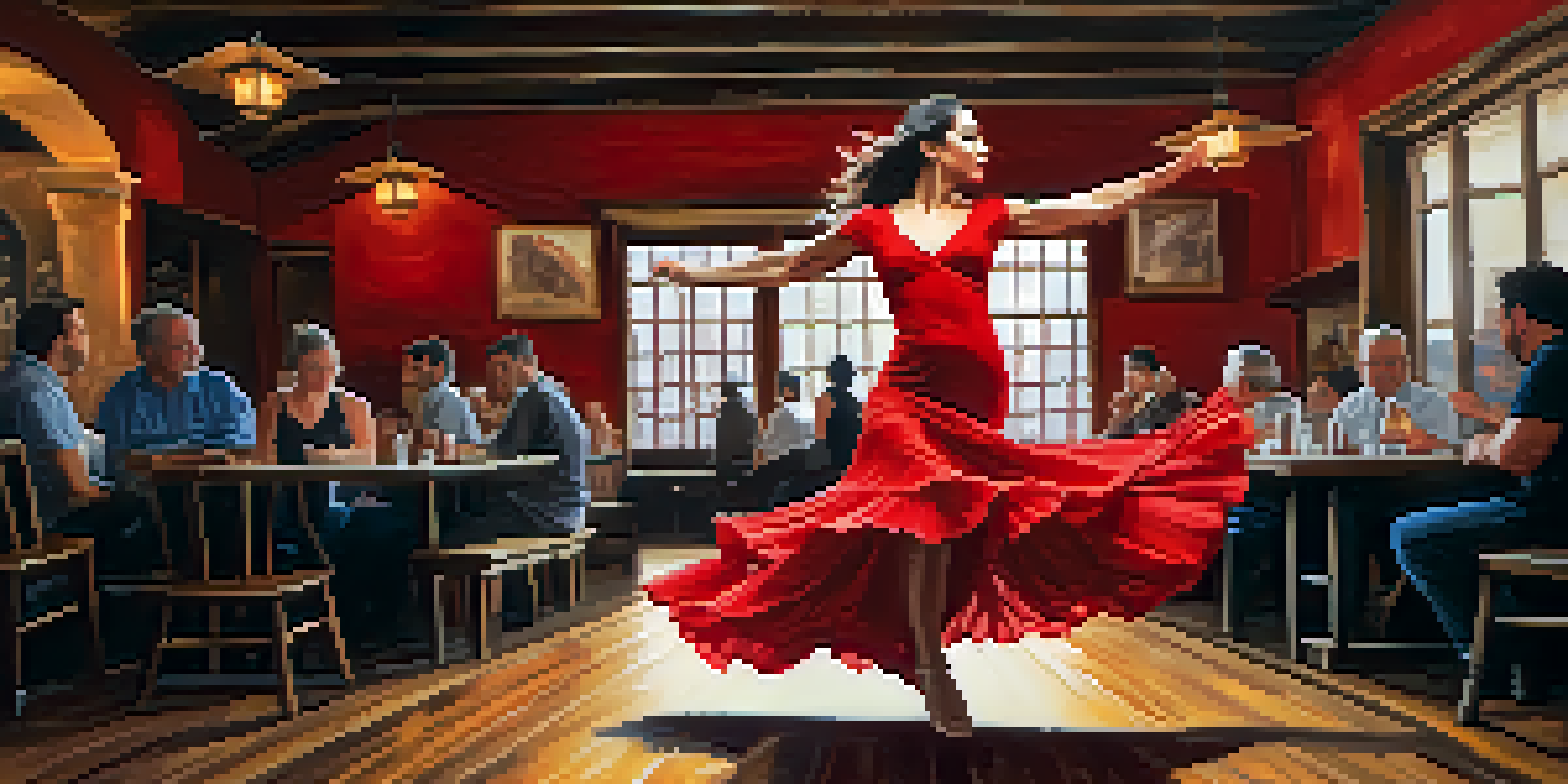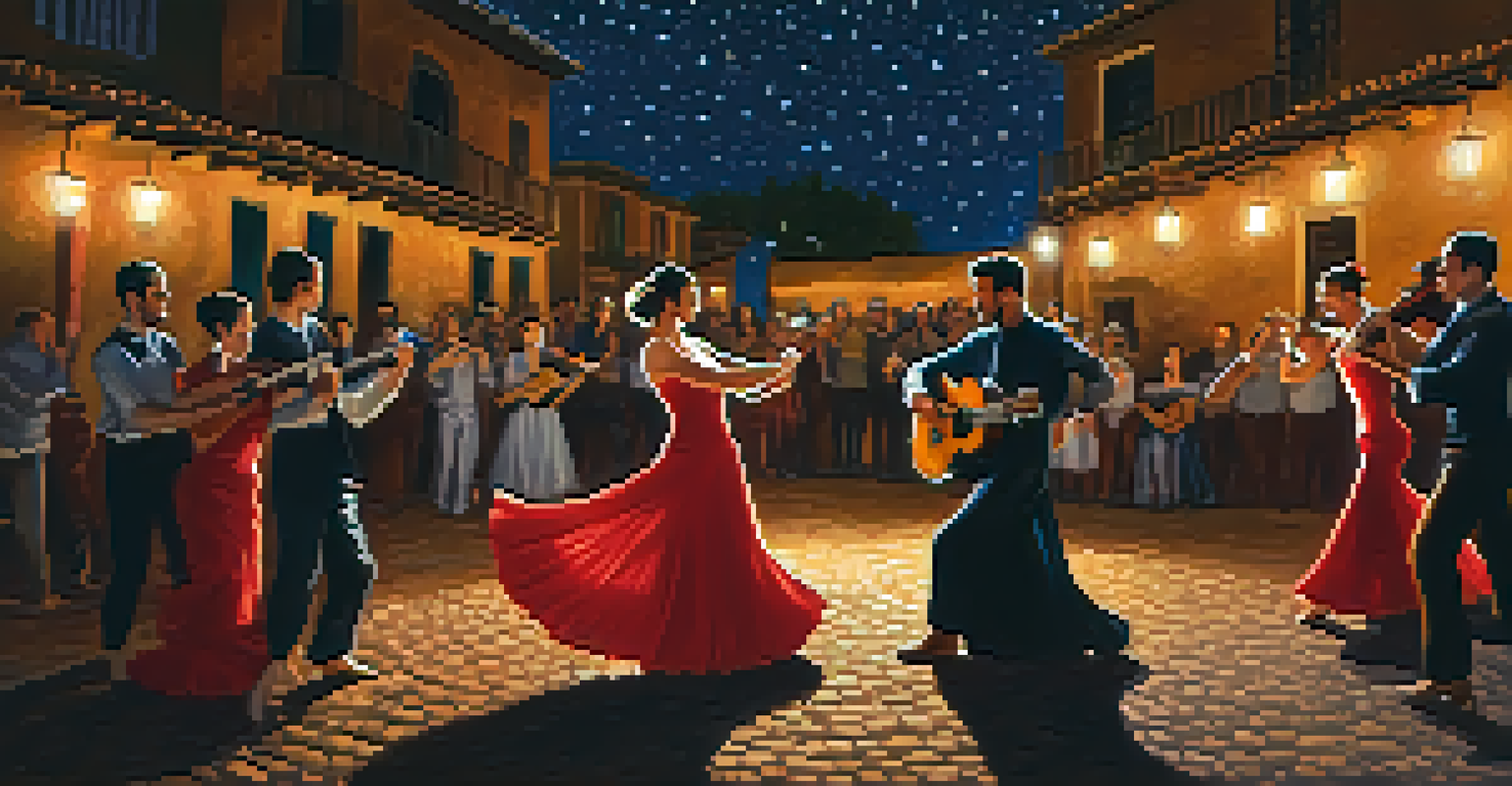The Evolution of Flamenco: From Folk Roots to Global Stage

Flamenco's Humble Beginnings in Andalusia
Flamenco originated in the Andalusian region of Spain, where it was deeply rooted in the cultural tapestry of the area. Its early forms emerged from the fusion of various influences, including Gypsy, Moorish, and Jewish traditions. This melting pot of cultures created a vibrant musical expression that resonated with the lives and struggles of the people.
Flamenco is a way of life, a way of expressing the soul, and a way of telling stories.
Initially, Flamenco was not a formalized art but rather a spontaneous form of expression among the working class. It was often performed at local gatherings, celebrations, and in the streets, emphasizing its communal and folk origins. The raw emotion and improvisation inherent in these performances laid the groundwork for what would eventually evolve into a more structured art form.
As time passed, the distinct sounds of the Flamenco guitar and the passionate rhythms of clapping and foot-stomping began to take shape. This unique blend of music and dance captured the hearts of those in the region, setting the stage for Flamenco's transformation into a recognized cultural phenomenon.
The Elements of Flamenco: Music and Dance
At the heart of Flamenco lies a rich interplay between music and dance, both essential to its identity. The music typically features guitar, palmas (hand clapping), and jaleo (shouts of encouragement), creating a rhythm that is both captivating and complex. Each element plays a crucial role in expressing the intense emotions that characterize Flamenco.

Flamenco dance, known for its intricate footwork and expressive arm movements, tells a story of passion, pain, and joy. Dancers often wear traditional costumes that enhance their movements, with women in flowing dresses and men in tight-fitting attire. The visual spectacle of Flamenco dance is as compelling as the music that accompanies it, creating a holistic experience for the audience.
Flamenco's Cultural Roots
Flamenco originated in Andalusia, blending Gypsy, Moorish, and Jewish influences to create a vibrant expression of community life.
Together, the music and dance form a dialogue that transcends words, allowing performers to convey their innermost feelings. This unique synergy is what makes Flamenco a powerful form of artistic expression, capturing the essence of human experience in each performance.
The Influence of Gypsy Culture on Flamenco
Gypsy culture has played a pivotal role in shaping the Flamenco tradition, contributing distinctive musical styles and dance techniques. The Romani people, who began migrating to Spain in the 15th century, brought with them their own rich musical heritage, which melded seamlessly with local folk traditions. This fusion created a dynamic and emotive art form that resonates deeply with audiences.
The beauty of Flamenco lies in its ability to communicate emotions that words cannot express.
Many Flamenco styles, or 'palos,' reflect the influence of Gypsy rhythms and melodies, showcasing a wide range of emotions from sorrowful to celebratory. The deep, soulful sounds of the Flamenco guitar are often reminiscent of Gypsy melodies, and this connection adds layers of meaning to the performances. The passion and expressiveness of Gypsy musicians and dancers have enriched Flamenco, making it a vital part of its evolution.
As Flamenco grew in popularity, it also became a symbol of the Gypsy identity, showcasing their struggles and triumphs through art. This cultural exchange has not only preserved the essence of Flamenco but has also elevated it to a global stage, where it continues to evolve.
Flamenco's Rise in the 19th Century
The 19th century marked a significant turning point for Flamenco, transitioning from a folk tradition to a more formalized art form. This era saw the establishment of the first Flamenco cafés, where performances became more structured and accessible to a wider audience. These venues played a crucial role in popularizing Flamenco, allowing it to thrive and evolve.
During this time, many artists began to gain recognition, and the art form started to attract the attention of intellectuals and artists. Writers, painters, and musicians were drawn to the passionate and emotive nature of Flamenco, which inspired a wave of creativity and innovation. This period also saw the introduction of new styles and techniques, further enriching the Flamenco repertoire.
Evolution into a Global Art
In the 20th century, Flamenco gained international acclaim, influenced by innovative artists and cross-cultural exchanges.
As Flamenco gained popularity, it began to influence and be influenced by other musical genres. This cross-pollination of styles contributed to its development and laid the foundation for the diverse Flamenco we know today. The 19th century was crucial in establishing Flamenco as a respected art form, setting the stage for its global journey.
Flamenco's Global Recognition in the 20th Century
The 20th century saw Flamenco break free from its regional roots and gain international acclaim. This transformation was propelled by the efforts of passionate artists who took Flamenco to stages around the world, showcasing its beauty and complexity. Festivals, tours, and collaborations with other artists helped ignite a global interest in this vibrant art form.
Iconic figures like the dancer Antonio Gades and guitarist Paco de Lucía played pivotal roles in elevating Flamenco to new heights. Their innovative approaches brought a fresh perspective to traditional Flamenco, incorporating contemporary elements while honoring its roots. This blend of tradition and innovation resonated with audiences far beyond Spain, leading to a wider appreciation of Flamenco.
As a result, Flamenco began to influence other genres of music and dance, creating a rich tapestry of cultural exchange. Today, Flamenco is celebrated worldwide, with performances and festivals dedicated to this art form, highlighting its evolution from local folk roots to a global phenomenon.
The Role of Technology in Flamenco's Evolution
Technology has significantly impacted the evolution of Flamenco, enhancing its reach and accessibility. The advent of recording technologies allowed Flamenco music to be preserved and shared, introducing it to new audiences. From vinyl records to streaming platforms, technology has played a crucial role in keeping Flamenco alive and relevant in today's digital age.
Social media has also become a powerful tool for Flamenco artists, enabling them to showcase their work to a global audience. Platforms like YouTube and Instagram allow dancers and musicians to share their performances, connect with fans, and collaborate with artists from different genres. This digital presence has led to a resurgence of interest in Flamenco, particularly among younger generations.
Technology's Impact on Flamenco
Modern technology has expanded Flamenco's reach and relevance, allowing artists to share their work globally and experiment with new styles.
Moreover, modern technology has facilitated the blending of Flamenco with other musical styles, creating exciting fusions that continue to evolve the genre. This adaptability ensures that Flamenco remains a vibrant and dynamic art form, capable of resonating with audiences around the world.
Flamenco Today: A Living Art Form
Today, Flamenco is a living, breathing art form that continues to evolve while honoring its rich heritage. Artists are experimenting with new styles and approaches, integrating influences from jazz, pop, and world music. This innovation breathes fresh life into Flamenco, attracting diverse audiences and ensuring its relevance in contemporary culture.
Flamenco festivals and competitions are thriving, showcasing both traditional and modern interpretations of the art form. These events provide a platform for emerging talent and celebrate the diverse expressions of Flamenco. They also foster a sense of community among artists and enthusiasts, keeping the spirit of Flamenco alive.

As Flamenco continues to gain recognition worldwide, it serves as a bridge between cultures, uniting people through shared experiences of emotion and artistry. This evolution reflects the resilience of Flamenco as an art form, ensuring that it will remain a vital part of the global cultural landscape for years to come.